
Mussel is the common name used for members of several families of bivalve molluscs, from saltwater and freshwater habitats. These groups have in common a shell whose outline is elongated and asymmetrical compared with other edible clams, which are often more or less rounded or oval.

Bivalvia, in previous centuries referred to as the Lamellibranchiata and Pelecypoda, is a class of marine and freshwater molluscs that have laterally compressed bodies enclosed by a shell consisting of two hinged parts. As a group, bivalves have no head and they lack some usual molluscan organs, like the radula and the odontophore. They include the clams, oysters, cockles, mussels, scallops, and numerous other families that live in saltwater, as well as a number of families that live in freshwater. The majority are filter feeders. The gills have evolved into ctenidia, specialised organs for feeding and breathing. Most bivalves bury themselves in sediment, where they are relatively safe from predation. Others lie on the sea floor or attach themselves to rocks or other hard surfaces. Some bivalves, such as the scallops and file shells, can swim. The shipworms bore into wood, clay, or stone and live inside these substances.

The New Zealand pea crab, Nepinnotheres novaezelandiae, is a small, parasitic crab that lives most commonly inside New Zealand green-lipped mussels. Adult females are about the size and shape of a pea, while adult males are smaller and flatter. Adult New Zealand pea crabs are completely reliant on their host mussel for shelter and food, which it steals from the mussel's gills. The New Zealand pea crab is found throughout New Zealand and can infect up to 70% of natural populations. These crabs are of concern to green-lipped mussel aquaculture because they reduce the size and growth of mussels, although infected mussels can be harvested and consumed.

A byssus is a bundle of filaments secreted by many species of bivalve mollusc that function to attach the mollusc to a solid surface. Species from several families of clams have a byssus, including pen shells (Pinnidae), true mussels (Mytilidae), and Dreissenidae.

The blue mussel, also known as the common mussel, is a medium-sized edible marine bivalve mollusc in the family Mytilidae, the mussels. Blue mussels are subject to commercial use and intensive aquaculture. A species with a large range, empty shells are commonly found on beaches around the world.
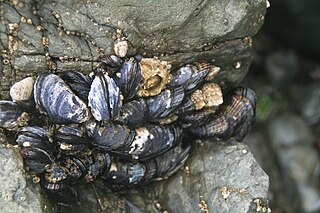
The California mussel is a large edible mussel, a marine bivalve mollusk in the family Mytilidae.
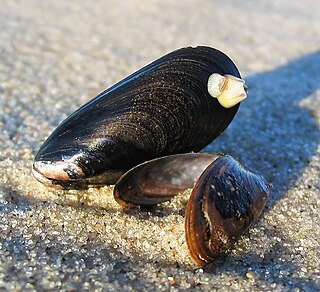
Mytilidae are a family of small to large marine and brackish-water bivalve molluscs in the order Mytilida. One of the genera, Limnoperna, even inhabits freshwater environments. The order has only this one family which contains some 52 genera.
Bioadhesives are natural polymeric materials that act as adhesives. The term is sometimes used more loosely to describe a glue formed synthetically from biological monomers such as sugars, or to mean a synthetic material designed to adhere to biological tissue.
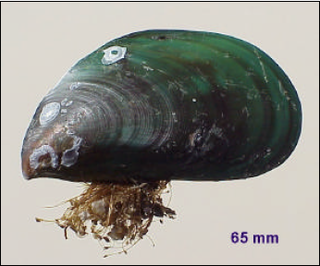
Perna viridis, known as the Asian green mussel, is an economically important mussel, a bivalve belonging to the family Mytilidae. It is harvested for food but is also known to harbor toxins and cause damage to submerged structures such as drainage pipes. It is native in the Asia-Pacific region but has been introduced in the Caribbean, and in the waters around Japan, North America, and South America.

Perna perna, the brown mussel, is an economically important mussel, a bivalve mollusc belonging to the family Mytilidae. It is harvested as a food source but is also known to harbor toxins and cause damage to marine structures. It is native to the waters of Africa, Europe, and South America and was introduced in the waters of North America.
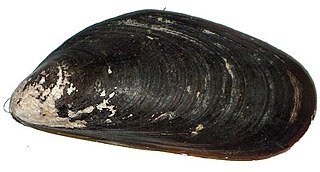
The Chilean mussel or Chilean blue mussel is a species of blue mussel native to the coasts of Chile, Argentina, Uruguay, the Falkland Islands and the Kerguelen islands. In the scientific literature, it has also been referred to as Southern Mytilus edulis, or Mytilus edulis platensis, or Mytilus chilensis.
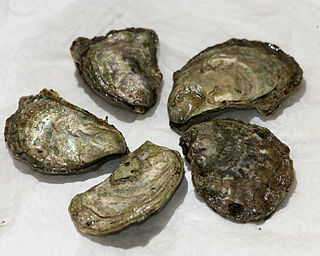
Ostrea lurida, common name the Olympia oyster, after Olympia, Washington in the Puget Sound area, is a species of edible oyster, a marine bivalve mollusk in the family Ostreidae. This species occurs on the northern Pacific coast of North America. Over the years the role of this edible species of oyster has been partly displaced by the cultivation of non-native edible oyster species.
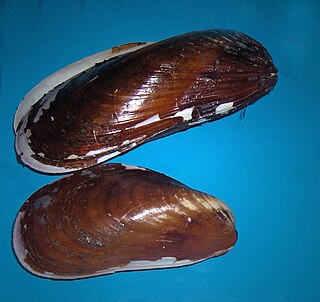
Modiolus modiolus, common name northern horsemussel, is a species of marine bivalve mollusk in the family Mytilidae.

The Mediterranean mussel is a species of bivalve, a marine mollusc in the family Mytilidae. It is an invasive species in many parts of the world, and also an object of aquaculture.
Urastoma cyprinae is a turbellarian that infects the gills of numerous species. It has been reported as free-living organism in marine mud and on algae. Urastoma cyprinae is reported as an opportunistic mantle inhabitant on the gills of various bivalve species, including the clams Tridacna maxima and Tridacna gigas, and the mussels Mytilus edulis and Mytilus galloprovincialis. They are also found throughout the gill surface of C. virginica and is attracted by mucus that coats the gills of oysters. However, the nature of the host-parasite relationship remains unknown.
Amygdalum papyrium, common name the Atlantic paper mussel, is a species of marine bivalve mollusc in the family Mytilidae, the true mussels. This species occurs along the Atlantic coast of North America, from Maryland to Florida, as well as in the Gulf of Mexico, from Texas to Mexico.
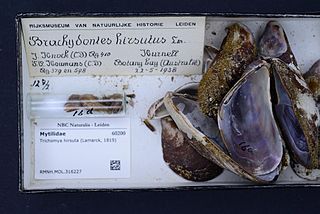
Trichomya is a monotypic genus of marine bivalve molluscs in the family Mytilidae, the mussels. The only species is Trichomya hirsuta which is endemic to southern and eastern Australia. Its common names include the hairy mussel, the greenling and the kelp greenling.
Pinctada fucata, the Akoya pearl oyster (阿古屋貝), is a species of marine bivalve mollusc in the family Pteriidae, the pearl oysters. Some authorities classify this oyster as Pinctada imbricata fucata. It is native to shallow waters in the Indo-Pacific region and is used in the culture of pearls.

Modiolus barbatus, the bearded horse mussel, is a species of "horse mussel", a marine bivalve mollusc in the family Mytilidae, the mussels.
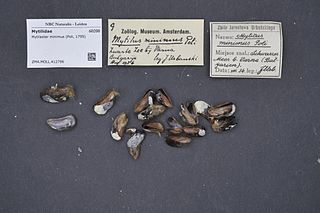
Mytilaster minimus, the dwarf mussel or variable mussel, is a species of mussel from sea and brackish waters of the Mediterranean Sea.


















